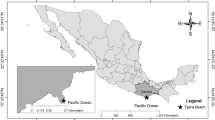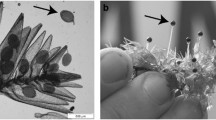Abstract
Lessonia berteroana is one of the most exploited seaweeds in the Southeastern Pacific and its populations are recurrently facing overexploitation in northern Chile. Since germplasms are not available, we decided to start gametophyte biobanking to support conservation measures for this important resource in the future. Spores of L. berteroana from nine localities at the Atacama coast were used to establish clonal male and female gametophyte cultures. Unexpectedly, after isolation and under low light conditions, juvenile sporophytes originated from somatic cells via apogamy in most female gametophyte strains. In addition, eggs from solitary female gametophytes from Caleta Cisnes and Torres del Inca had a strong tendency to generate sporophytes by parthenogenesis, some of them even under low light regimes. Contrarily, female gametophytes of the sister species Lessonia spicata from southern Chile showed no evidence for apomixis. When one of these L. berteroana strains is cross-fertilized with L. spicata, true hybrids emerged based on the presence of eggs and subsequent sperm attraction. These observations contrast with (i) kelp recruitment assumed to be majorly by sexual reproduction and (ii) the strict reproductive separation of the two taxa reported for natural populations within their contact zone at 30°S and highlight their consideration for future repopulation and breeding programs of Lessonia.


Similar content being viewed by others
References
Barcaccia G, Albertini E (2013) Apomixis in plant reproduction: a novel perspective on an old dilemma. Plant Reprod 26:159–179
Bicknell RA, Koltunow AM (2004) Understanding apomixis: recent advances and remaining conundrums. Plant Cell 16:S228–S245
Coleman M, Wernberg T (2018) Genetic and morphological diversity in sympatric kelps with contrasting reproductive strategies. Aquat Biol 27:65–73
Cosendai A-C, Hörandl E (2010) Cytotype stability, facultative apomixis and geographical parthenogenesis in Ranunculus kuepferi (Ranunculaceae). Ann Bot 105:457–470
Demes KW, Graham MH (2011) Abiotic regulation of investment in sexual versus vegetative reproduction in the clonal kelp Laminaria sinclairii (Laminariales, Phaeophyceae). J Phycol 47:463–470
González A, Beltrán J, Hiriart-Bertrand L, Flores V, de Reviers B, Correa JA, Santelices B (2012) Identification of cryptic species in the Lessonia nigrescens complex (Phaeophyceae, Laminariales). J Phycol 48:1153–1165
Hoffmann AJ, Santelices B (1982) Effects of light intensity and nutrients on gametophytes and gametogenesis of Lessonia nigrescens Bory (Phaeophyta). J Exp Mar Biol Ecol 60:77–89
Krueger-Hadfield SA, Kollars NM, Byers JE, Greig TW, Hammann M, Murray DC, Murren CJ, Strand AE, Terada R, Weinberg F, Sotka EE (2016) Invasion of novel habitats uncouples haplo-diplontic life cycles. Mol Ecol 25:3801–3816
Le Gall Y, Asensi A, Marie D, Kloareg B (1996) Parthenogenesis and apospory in the Laminariales: a flow cytometry analysis. Eur J Phycol 31:369–380
Lüning K, Dring MJ (1975) Reproduction, growth and photosynthesis of gametophytes of Laminaria saccharina grown in blue and red light. Mar Biol 29:195–200
Lüning K, Neushul M (1978) Light and temperature demands for growth and reproduction of laminarian gametophytes in southern and Central California. Mar Biol 45:297–309
Macaya EC, Zuccarello GC (2010) DNA barcoding and genetic divergence in the giant kelp Macrocystis (laminariales). J Phycol 46:736–742
Müller DG, Gachon CMM, Küpper FC (2008) Axenic clonal cultures of filamentous brown algae: initiation and maintenance. Cah Biol Mar 49:59–65
Müller DG, Maier I, Marie D, Westermeier R (2016) Nuclear DNA level and life cycle of kelps: evidence for sex-specific polyteny in Macrocystis (Laminariales, Phaeophyceae). J Phycol 52:157–160
Murúa P, Westermeier R, Patiño DJ, Müller DG (2013) Culture studies on early development of Lessonia trabeculata (Phaeophyceae, Laminariales): seasonality and acclimation to light and temperature. Phycol Res 61:145–153
Murúa P, Müller DG, Patiño DJ, Westermeier R (2017) Giant kelp vegetative propagation: adventitious holdfast elements rejuvenate senescent individuals of the Macrocystis pyrifera “integrifolia” ecomorph. J Phycol 53:230–234
Nakahara H, Nakamura Y (1973) Parthenogenesis, apogamy and apospory in Alaria crassifolia (Laminariales). Mar Biol 18:327–332
Oppliger LV, Correa JA, Peters AF (2007) Parthenogenesis in the brown alga Lessonia nigrescens (Laminariales, Phaeophyceae) from Central Chile. J Phycol 43:1295–1301
Oppliger LV, von Dassow P, Bouchemousse S, Robuchon M, Valero M, Correa JA, Mauger S, Destombre C (2014) Alteration of sexual reproduction and genetic diversity in the kelp species Laminaria digitata at the southern limit of its range. PLoS One 9:e102518
Percival EE, Venegas Jara MF, Weigel H (1983) Carbohydrates of the brown seaweed Lessonia nigrescens. Phytochemistry 22:1429–1432
Peteiro C (2018) Alginate production from marine macroalgae, with emphasis on kelp farming. In: Rehm B, Moradali M (eds) Alginates and their biomedical applications. Springer, Singapore, pp 27–66
Richards AJ (2003) Apomixis in flowering plants: an overview. Philos Trans R Soc B 358:1085–1093
Shan TF, Pang SJ, Gao SQ (2013) Novel means for variety breeding and sporeling production in the brown seaweed Undaria pinnatifida (Phaeophyceae): crossing female gametophytes from parthenosporophytes with male gametophyte clones. Phycol Res 61:154–161
Starr RC, Zeikus JA (1993) UTEX-the culture collection of algae at the University of Texas at Austin 1993. List of cultures. J Phycol 29:1–106
Tatarenkov A, Bergström L, Jönsson RB, Serrao EA, Kautsky L, Johannesson K (2005) Intriguing asexual life in marginal populations of the brown seaweed Fucus vesiculosus. Mol Ecol 14:647–651
Tellier F, Tapia J, Faugeron S, Destombe C, Valero M (2011) The Lessonia nigrescens species complex (Laminariales, Phaeophyceae) shows strict parapatry and complete reproductive isolation in a secondary contact zone. J Phycol 47:894–903
Voigt PW (1971) Discovery of sexuality in Eragrostis curvula (Schrad.) Nees. Crop Sci 11:424
Voigt PW, Bashaw EC (1976) Facultative apomixis in Eragrostis curvula. Crop Sci 16:803
Walther G-R, Roques A, Hulme PE, Sykes MT, Pysek P, Kühn I, Zobel M, Bacher S, Botta-Dukát Z, Bugmann H, Czúcz B, Dauber J, Hickler T, Jarosík V, Kenis M, Klotz S, Minchin D, Moora M, Nentwig W, Ott J, Panov VE, Reineking B, Robinet C, Semenchenko V, Solarz W, Thuiller W, Vilà M, Vohland K, Settele J (2009) Alien species in a warmer world: risks and opportunities. Trends Ecol Evol 24:686–693
Westermeier R, Patino D, Piel MI, Maier I, Müller DG (2006) A new approach to kelp mariculture in Chile: production of free-floating sporophyte seedlings from gametophyte cultures of Lessonia trabeculata and Macrocystis pyrifera. Aquac Res 37:164–171
Westermeier R, Patiño D, Müller DG (2007) Sexual compatibility and hybrid formation between the giant kelp species Macrocystis pyrifera and M. integrifolia (Laminariales, Phaeophyceae) in Chile. J Appl Phycol 19:215–221
Westermeier R, Patiño DJ, Murúa P, Müller DG (2011) Macrocystis mariculture in Chile: growth performance of heterosis genotype constructs under field conditions. J Appl Phycol 23:819–825
Westermeier R, Murúa P, Patiño DJ, Muñoz L, Müller DG (2016) Holdfast fragmentation of Macrocystis pyrifera (integrifolia morph) and Lessonia berteroana in Atacama (Chile): a novel approach for kelp bed restoration. J Appl Phycol 28:2969–2977
Westermeier R, Murúa P, Patiño DJ, Manoli G, Müller DG (2018) Evaluation of kelp harvest strategies: recovery of Lessonia berteroana (Phaeophyceae, Laminariales) in Pan de Azucar, Atacama, Chile. J Appl Phycol. https://doi.org/10.1007/s10811-018-1500-8
Zappacosta DC, Ochogavía AC, Rodrigo JM, Romero JR, Meier MS, Garbus I, Pessino SC, Echenique VC (2015) Increased apomixis expression concurrent with genetic and epigenetic variation in a newly synthesized Eragrostis curvula polyploid. Sci Rep 4:4423
Acknowledgements
Sincere thanks are due to C. Atero for collection of field samples, U. Hueppeler and I. Maier for support with art-work and to the three anonymous reviewers for their contributions that helped to improve the earlier version of this MS. This work was done in the framework of the projects FIC 2013 33-91-243, FIC 2015 33-01-244 and FIC 2016 40486116 (GORE Atacama), FONDEF D04I1288 and VW Foundation, granted to the Universidad Austral de Chile (RW).
Author information
Authors and Affiliations
Corresponding author
Electronic supplementary material
Table S1
(DOCX 19 kb)
Rights and permissions
About this article
Cite this article
Müller, D.G., Murúa, P. & Westermeier, R. Reproductive strategies of Lessonia berteroana (Laminariales, Phaeophyceae) gametophytes from Chile: Apogamy, parthenogenesis and cross-fertility with L. spicata. J Appl Phycol 31, 1475–1481 (2019). https://doi.org/10.1007/s10811-018-1625-9
Received:
Revised:
Accepted:
Published:
Issue Date:
DOI: https://doi.org/10.1007/s10811-018-1625-9




